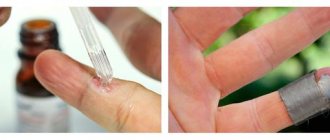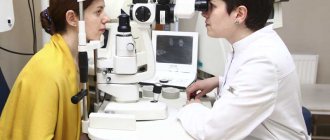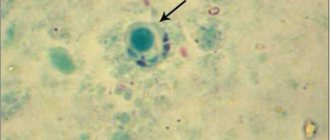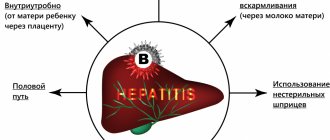What do they really look like?
Very often, patients who come to see me ask to remove a papilloma or several of them and indicate a pigmented nevus, fibropapilloma or wart. Once I was offered a tick to remove a papilloma (I’m not kidding):
I consider it necessary to clearly define what papilloma is and how it differs from other skin neoplasms. Most often this is a small, 1-3 mm skin formation on a thin stalk. There are three main differences between papilloma and other skin formations. First, the leg is always thinner than the top. Secondly, the consistency of papilloma is always softer than the surrounding skin. Third, the size of the papilloma is usually small - no more than 5 mm. The photo below shows a typical papilloma.
How to get rid of papillomas?
There are only two main methods of treating papillomas
- The simplest and most effective method of treatment is the removal of papillomas using various methods ( laser, radio wave surgery, electrocoagulation
, etc.). In most cases, a one-time complete removal of papillomas from the entire body is sufficient. I will tell you in more detail about how papillomas are removed using radio wave surgery in our clinic below. - Removing papillomas at home
has recently become a very popular method . Most often, this happens with the help of two types of drugs - acid solutions with names like “Super Celandine” and a mixture of dimethyl ether and propane (the popular drug “Cryopharma”). I can’t say anything about the effectiveness of these two methods, because... I have never removed papillomas this way.
IMPORTANT!!!!
Please do not diagnose yourself with papilloma based on research on the Internet. Before using the above drugs, you should always see an oncologist and make sure that what you are going to remove at home is really a papilloma. If the diagnosis is made incorrectly and any of these liquids are applied to the pigmented nevus, the consequences can be extremely sad.
How is papillomas removed?
In our clinic, papillomas are removed using radio wave surgery. Just watch this short video and many questions will disappear by themselves.
The papilloma is fixed with special tweezers, after which a loop-shaped instrument is cut off from the skin at the base. At the moment of contact with the skin, a high-frequency radio wave is concentrated at the end of the instrument, which evaporates papilloma cells and at the same time “glues” blood vessels together. As a rule, anesthesia is not required for this procedure - the pain is comparable to epilation with tweezers. In rare cases, pain relief is performed with EMLA cream.
Causes
As mentioned above, papillomas appear as a result of human infection with HPV. Moreover, the virus can remain latent in the body for a long time and not cause any clinical manifestations. Currently, more than 30% of the world's population is infected with HPV.
Papillomas appear when the body is exposed to provoking factors, such as:
- Decreased immunity. When the intensity of the body’s defense weakens, HPV becomes active and leads to the formation of growths.
- Unprotected sexual contact (oral, vaginal, anal) with a partner who is a carrier of the virus.
- Bad habits. Smoking and excessive alcohol consumption not only harm health in general, but also provoke HPV activity if it is present in the body.
- STDs: chlamydia, thrush, gonorrhea also contribute to the formation of papillomas on the skin and mucous membranes of the genital organs.
- Long-term use of antibacterial drugs and oral contraceptives.
- Constant stressful situations, depression and emotional stress.
Briefly about the main thing:
If you decide to get rid of papillomas, there are 2 ways: The first is to remove papillomas in the clinic, preferably from an oncologist. The advantages of this method are obvious - maximum efficiency and safety. The second method is removal at home using drugs that can be bought in pharmacies. The advantage of this method is its low cost, however, for safe removal, I recommend first consulting with an oncologist. If treatment of papillomas with none of the above methods is effective, it is worth checking your immunity. To do this, it is better to consult an immunologist.
Have you decided to part with your papillomas? This can be done at addresses in St. Petersburg (Asafieva 7/1)
Human papillomavirus - which HPV treatment is effective?
What is human papillomavirus?
The HPV group of viruses is part of the papillomavirus family, which includes 5 genera, about 43 varieties and almost 170 types, and it is HPV that causes the formation of warts. There is a direct connection between it and cervical cancer: this virus is detected in 92% of cancer cases.
What tests are done for human papillomavirus?
The main areas of research are determining the viral load, that is, a quantitative indicator and determining the type of virus using the PCR method.
Are papillomas dangerous?
In essence, papilloma is a benign tumor, but it is also fraught with danger. Firstly, damage to its integrity is possible, leading to the formation of scars and, rarely, blood poisoning. It is not recommended to remove papillomas mechanically on your own; this can lead to generalization of the process and the spread of papillomas throughout the body. The main danger of papillomas is that they are viral. Most types of HPV do not pose a threat to human health and life, but HPV types 16 and 18 can provoke the development of malignant tumors. Benign papillomas, as a rule, cause a lot of trouble to a person. They can grow to large sizes and can form in the genital area. Some types of HPV cause precancerous lesions.
Is human papillomavirus contagious?
HPV can be transmitted in various ways. With contact and household transmission, the virus is transmitted through the skin through handshakes and the use of personal hygiene products, after trying on someone else's clothes and underwear, and when visiting public swimming pools and saunas. Sexual transmission of the virus is considered especially dangerous, since there is a high risk of infection with oncogenic HPV. The likelihood of sexual transmission of the virus is much higher if the partner has genital warts. HPV can be passed from mother to child during childbirth, although it rarely occurs during pregnancy. In this case, most often children develop laryngeal papillomatosis, which can cause serious respiratory problems. It is possible for a child to become infected from the mother during breastfeeding.
How is human papillomavirus treated?
Drug treatment of the virus is carried out using drugs that act on the cause of the disease and also restore the function of the immune system. There are various schemes for intravenous drug administration; doctors, as a rule, prescribe treatment individually; there are no standard schemes. What drugs are usually prescribed? Cycloferon, Interferon alfa, Panavir, Ingaron. Tablet forms of antiviral drugs: Isoprinosine, Lykopid, Lavomax, Alpizarin. Candles: Genferon, Betadine, Viferon. Ointments: Oxolinic ointment, San Fen Zhong ointment, Stefalin, Salicylic ointment. Vitamins: Aevit, Alphabet.
Vaccination against HPV (Gardasil)
It is still impossible to completely get rid of HPV at the current level of the pharmaceutical industry, but it is possible to prevent infection and for this purpose vaccination is carried out with a drug such as Gardasil. In some countries, these vaccinations are already mandatory; in Russia, vaccination can be done voluntarily. When choosing this method of preventing HPV, it is necessary to undergo a preliminary examination to determine the presence of the virus in the body. Vaccines contain synthetically modified proteins similar to the structure of the virus. The introduction of these proteins into the body activates the immune system and leads to the production of antibodies that protect against the development of HPV after the pathogen enters the body. Vaccine developers advise giving the drug to girls and boys aged 10 to 12 years. This is due to the fact that at this age, in the vast majority of cases, there is no sexual intercourse, and the immune system works at full strength, which contributes to a good response to the drug.
Can human papillomavirus cause cancer?
The most dangerous type of HPV that causes malignant tumors is the following: HPV-16; HPV-18; HPV-31, 33, 45, 56, 58; HPV-51, 59, 68; HPV-35, 39, 52.
What types of cancer does HPV cause?
Most often, cervical cancer is caused by human papillomavirus types 16 and 18, which also cause genital cancer. HPV 16 is the cause of laryngeal cancer in 50% of cases.
Is HPV sexually transmitted?
HPV is transmitted sexually, and sexual contact itself becomes the main cause of infection with the papilloma virus. Let's talk about this in more detail.
Papillomas located on the penis are a sign of human papillomavirus infection, therefore sexually transmitted infection is quite logical. The incubation period for HPV lasts from 1 to 12 months. In this case, the papillomas themselves may not grow at all, and only with a decrease in the function of the immune system can their formation begin. Therefore, detection of HPV in the body in the early stages of disease development is possible only with the help of special tests. Currently, HPV is one of the most common diseases and the risk of infecting a partner during unprotected sexual intercourse is almost 100%.
Are papillomas a cancer?
All types of HPV, according to the degree of risk of malignant degeneration, can be divided into the following: low risk, medium risk and high oncogenic (carcinogenic) risk. Genital warts in the genital area, as a rule, are not caused by a highly oncogenic virus. Squamous cell papillomas are malignant neoplasms. Patients diagnosed with squamous cell papillomas are at increased risk and require immediate treatment.
If a patient is diagnosed with HPV of the oncogenic group, in order to prevent the appearance of oncological processes in the body, it is necessary to pay attention to the immune system, regularly undergo tests and be observed by a doctor.
Is it possible to give birth if you have the human papillomavirus?
If HPV is detected in a woman’s body, but there are no external manifestations in the form of papillomas, then you can give birth calmly and not worry. If there are genital warts in the genital area, then there is a very high risk of the child becoming infected with HPV while passing through the birth canal. The child’s first independent breath can occur right in the birth canal; the virus entering the baby’s throat leads to the growth of papillomas on his vocal folds. Therefore, in the presence of genital papillomas and an active form of HPV, a cesarean section is indicated.
Can human papillomavirus go away without treatment?
According to statistics, in 85% of cases, HPV after infection is eliminated by the body on its own, thanks to the good functioning of the immune system. This process can last from several months to several years. Sometimes the presence of the virus in the human body may not be detected even during a medical examination. The presence of HPV can be fully confirmed by the presence of formations on the skin - papillomas.
What to do if you are diagnosed with human papillomavirus?
Dermatologists recommend:









